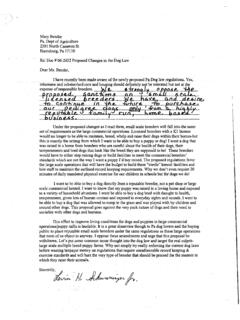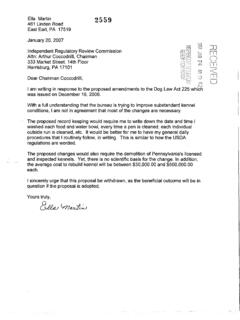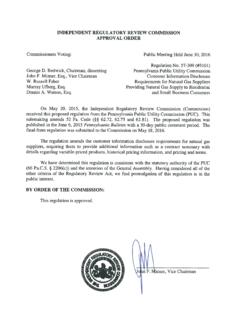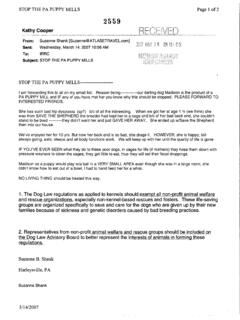Transcription of PREFACE - IRRC
1 PREFACE . The General Assembly passed the Regulatory Review Act (RRA) in 1982. The RRA. established the Independent Regulatory Review Commission (IRRC) to provide uniform oversight of the rulemaking process in Pennsylvania and to act as a consensus builder among Commonwealth agencies, legislative standing committees, and interested parties. IRRC is charged with reviewing all regulations that Commonwealth agencies propose for promulgation, except those of the Pennsylvania Game Commission and the Pennsylvania Fish and Boat Commission.
2 IRRC accomplishes the goals of the RRA typically through a two-stage review process. First, IRRC reviews an agency's proposed regulation and any accompanying comments from the public and the General Assembly, and issues formal comments when necessary. Second, IRRC reviews and takes action on the final version of the regulation before it is published as a final rule. There are five IRRC Commissioners, each of whom is appointed by a different appointing authority. The appointing authorities are the Governor, the President Pro Tempore of the Senate, the Minority Leader of the Senate, the Speaker of the House of Representatives, and the Minority Leader of the House of Representatives.
3 A Commissioner may not be a Commonwealth employee or hold an elected or appointed position in state government. IRRC also acts as a clearinghouse for complaints, comments, and other input from the General Assembly and the public regarding proposed and final regulations, as well as existing regulations. It further assists agencies and the public by conducting seminars and workshops. This manual is devoted to a discussion of the RRA, related laws, and how IRRC and others involved in the review process conduct their business.
4 Sections I and III provide both an overview and a detailed analysis of the regulatory review process. Section II explains statements of policy and the very limited circumstances under which they may fall under review. Section IV offers opportunities for agencies to build consensus with regulated communities. Section V. describes aspects of the review process that are used less frequently than those described in the previous sections. Sections VI and VII include information on IRRC's Annual Report and website, respectively.
5 The Appendices provide additional explanatory material on information contained in this manual. I. TABLE OF CONTENTS. I. AN OVERVIEW OF THE RULEMAKING PROCESS .. 1. A. Generally .. 1. B. Applicable 2. 1. CDL Framework & LRB .. 2. 2. Administrative Code Fiscal Notes .. 3. 3. Commonwealth Attorneys Act Legal Review .. 3. a. General Counsel .. 3. b. Attorney General .. 4. 4. RRA Formal Review Process .. 5. II. STATEMENTS OF POLICY .. 6. A. Joint Committee on Documents .. 6. B. Litigation .. 7. III. THE REGULATORY REVIEW PROCESS.
6 8. A. Proposed Stage .. 8. 1. Delivery and Publication of the Proposed Regulation .. 8. 2. Public Comment Period .. 9. 3. Standing Committee Review .. 11. 4. IRRC Review .. 11. 5. Agency Response .. 13. B. Final Stage .. 13. 1. Delivery of the Final-Form or Final-Omitted Regulation .. 14. 2. Time Period for Review by Committees and IRRC .. 15. 3. 48-Hour Blackout Period .. 16. 4. Agency Option to Withdraw Before IRRC Action .. 16. 5. IRRC Public Meetings .. 17. a. IRRC Approval with Committee Approval .. 18. b. IRRC Approval with Committee Disapproval or Notice of Intent to Review.
7 18. c. IRRC Disapproval .. 19. 6. Agency Options after IRRC Disapproval .. 19. a. Resubmit with or Without Revisions .. 19. b. Withdraw the Regulation .. 20. c. Take No Action Regulation is Deemed to be Withdrawn .. 20. 7. Committee Actions .. 20. a. Additional Review Period for Committees .. 20. b. Review by the General Assembly The Concurrent Resolution Process .. 21. 8. Governor's Action on Concurrent 22. II. IV. OPPORTUNITIES FOR BUILDING CONSENSUS .. 23. A. Proposed Stage .. 23. B. Final Stage .. 23. 1. Tolling the Time for Review.
8 23. 2. Withdrawal of a Regulation .. 24. V. ADDITIONAL STEPS WITHIN AND OUTSIDE THE REVIEW PROCESS .. 25. A. Final-Omitted Regulations .. 25. B. Emergency Certified Regulations .. 26. C. Temporary 26. D. Existing 27. E. Advance Notice of Proposed Rulemaking .. 27. F. Advance Notice of Final Rulemaking .. 27. G. Published and Unpublished Documents .. 27. H. Subpoena Power .. 28. VI. ANNUAL REPORT .. 28. VII. IRRC WEBSITE ( ) .. 28. APPENDICES. Appendix A. Two-Stage Regulatory Review Process (Summary) .. 30. Appendix B.
9 Regulatory Review Act Criteria (71 ) .. 31. Appendix C. Regulatory Analysis Form Contents .. 33. Appendix D. Sample Regulatory Package (Proposed Stage) .. 35. Appendix E. Sample Regulatory Package (Final Stage) .. 36. Appendix F. Glossary .. 37. TABLE OF CHARTS. Proposed Stage .. 8. Final Stage .. 14. IRRC Approval with Committee Approval .. 18. IRRC Approval with Committee Disapproval or Notice of Intent to Review .. 18. IRRC Disapproval .. 19. Review by the General Assembly The Concurrent Resolution Process .. 21.
10 Governor's Action on Concurrent Resolution .. 22. Tolling the Time for Review .. 24. Two-Stage Regulatory Review Process (Summary) .. 30. III. I. AN OVERVIEW OF THE RULEMAKING PROCESS. A. GENERALLY. Pursuant to their respective enabling statutes, Commonwealth agencies have the authority, discretion and, to the extent necessary, the responsibility to promulgate regulations. Depending upon the circumstances, an agency may have to: 1. Create, amend, or repeal a regulation to implement legislation;. 2. Ensure that existing regulations do not conflict with a recently enacted or amended federal or state regulation or statute.












